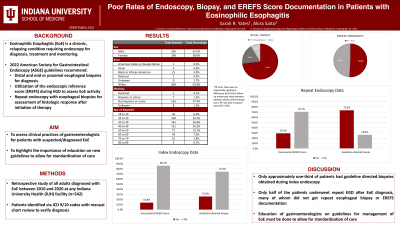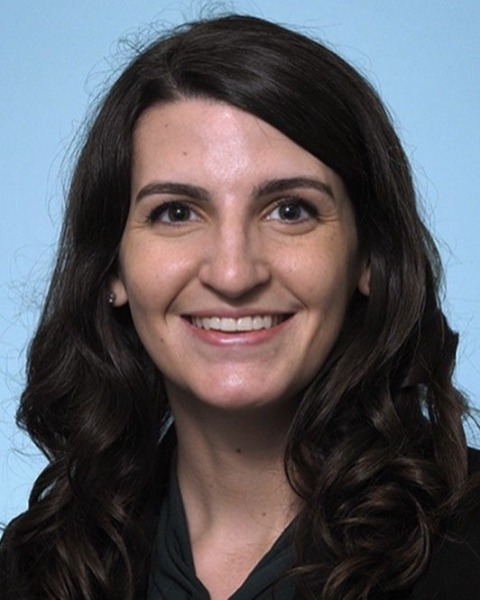Monday Poster Session
Category: Esophagus
P1811 - Poor Rates of Endoscopy, Biopsy, and EREFS Score Documentation in Patients with Eosinophilic Esophagitis
Monday, October 23, 2023
10:30 AM - 4:15 PM PT
Location: Exhibit Hall

Has Audio

Sarah R. Yates, DO
Indiana University
Indianapolis, IN
Presenting Author(s)
Sarah Yates, DO, Akira Saito, MD
Indiana University, Indianapolis, IN
Introduction: Eosinophilic Esophagitis (EoE) is a chronic, relapsing condition requiring endoscopy for diagnosis, treatment, and monitoring of therapeutic response. The 2022 American Society for Gastrointestinal Endoscopy (ASGE) guidelines recommend that biopsies be taken from the distal and mid or proximal esophagus for the diagnosis of EoE. They also recommend repeat endoscopy with esophageal biopsies after initiation of therapy to assess for histologic response and utilization of the endoscopic reference score (EREFS) during EGD to assess EoE activity. We hypothesize that a significant number of gastroenterologists have not been following these clinical practices.
Methods: This is a retrospective study of adults diagnosed with EoE between 2010 and 2020 at any Indiana University Health (IUH) facility. Patients were identified via ICD 9/10 codes, and manual chart review was performed to verify EoE diagnosis. Demographics, treatment, repeat EGD, EREFS, and biopsy data were collected and analyzed.
Results: 542 patients from 24 IUH-affiliated facilities under care of 87 different gastroenterologists were identified. 62.0% were male and 92.3% were Caucasian. On index endoscopy, 13.8% of all patients diagnosed with EoE were given an EREFS score. Biopsies were obtained from the distal and mid or proximal esophagus in 25.8% of patients (19.9% obtained only distal and mid, 5.9% distal and proximal). In 5.7% of cases, biopsies were obtained in all three locations. The most common first line therapy was a proton pump inhibitor (PPI) (73.2%) and the second most common was topical steroids (18.1%). Of all patients diagnosed with EoE, only 50.9% underwent repeat endoscopy. Of those, 73.6% had esophageal biopsies taken and 29.3% were given an EREFS score. There was no statistically significant difference (p=0.18) in follow up endoscopy rates between patients whose initial therapy was a PPI (51.4%) and those whose initial therapy was a steroid (51.4%).
Discussion: The baseline adherence to the 2022 ASGE guidelines for EoE management is quite poor. Historically, approximately one third of patients had guideline-directed biopsies obtained. The rest of the patients had biopsies taken in one location or the location of the biopsies was unreported. Only half of patients had repeat EGD after diagnosis of EoE, many of whom did not get repeat esophageal biopsies or documentation of EREFS. This highlights the importance of educating gastroenterologists on the new guidelines to allow more standardized care when treating EoE.
Disclosures:
Sarah Yates, DO, Akira Saito, MD. P1811 - Poor Rates of Endoscopy, Biopsy, and EREFS Score Documentation in Patients with Eosinophilic Esophagitis, ACG 2023 Annual Scientific Meeting Abstracts. Vancouver, BC, Canada: American College of Gastroenterology.
Indiana University, Indianapolis, IN
Introduction: Eosinophilic Esophagitis (EoE) is a chronic, relapsing condition requiring endoscopy for diagnosis, treatment, and monitoring of therapeutic response. The 2022 American Society for Gastrointestinal Endoscopy (ASGE) guidelines recommend that biopsies be taken from the distal and mid or proximal esophagus for the diagnosis of EoE. They also recommend repeat endoscopy with esophageal biopsies after initiation of therapy to assess for histologic response and utilization of the endoscopic reference score (EREFS) during EGD to assess EoE activity. We hypothesize that a significant number of gastroenterologists have not been following these clinical practices.
Methods: This is a retrospective study of adults diagnosed with EoE between 2010 and 2020 at any Indiana University Health (IUH) facility. Patients were identified via ICD 9/10 codes, and manual chart review was performed to verify EoE diagnosis. Demographics, treatment, repeat EGD, EREFS, and biopsy data were collected and analyzed.
Results: 542 patients from 24 IUH-affiliated facilities under care of 87 different gastroenterologists were identified. 62.0% were male and 92.3% were Caucasian. On index endoscopy, 13.8% of all patients diagnosed with EoE were given an EREFS score. Biopsies were obtained from the distal and mid or proximal esophagus in 25.8% of patients (19.9% obtained only distal and mid, 5.9% distal and proximal). In 5.7% of cases, biopsies were obtained in all three locations. The most common first line therapy was a proton pump inhibitor (PPI) (73.2%) and the second most common was topical steroids (18.1%). Of all patients diagnosed with EoE, only 50.9% underwent repeat endoscopy. Of those, 73.6% had esophageal biopsies taken and 29.3% were given an EREFS score. There was no statistically significant difference (p=0.18) in follow up endoscopy rates between patients whose initial therapy was a PPI (51.4%) and those whose initial therapy was a steroid (51.4%).
Discussion: The baseline adherence to the 2022 ASGE guidelines for EoE management is quite poor. Historically, approximately one third of patients had guideline-directed biopsies obtained. The rest of the patients had biopsies taken in one location or the location of the biopsies was unreported. Only half of patients had repeat EGD after diagnosis of EoE, many of whom did not get repeat esophageal biopsies or documentation of EREFS. This highlights the importance of educating gastroenterologists on the new guidelines to allow more standardized care when treating EoE.
Disclosures:
Sarah Yates indicated no relevant financial relationships.
Akira Saito indicated no relevant financial relationships.
Sarah Yates, DO, Akira Saito, MD. P1811 - Poor Rates of Endoscopy, Biopsy, and EREFS Score Documentation in Patients with Eosinophilic Esophagitis, ACG 2023 Annual Scientific Meeting Abstracts. Vancouver, BC, Canada: American College of Gastroenterology.
